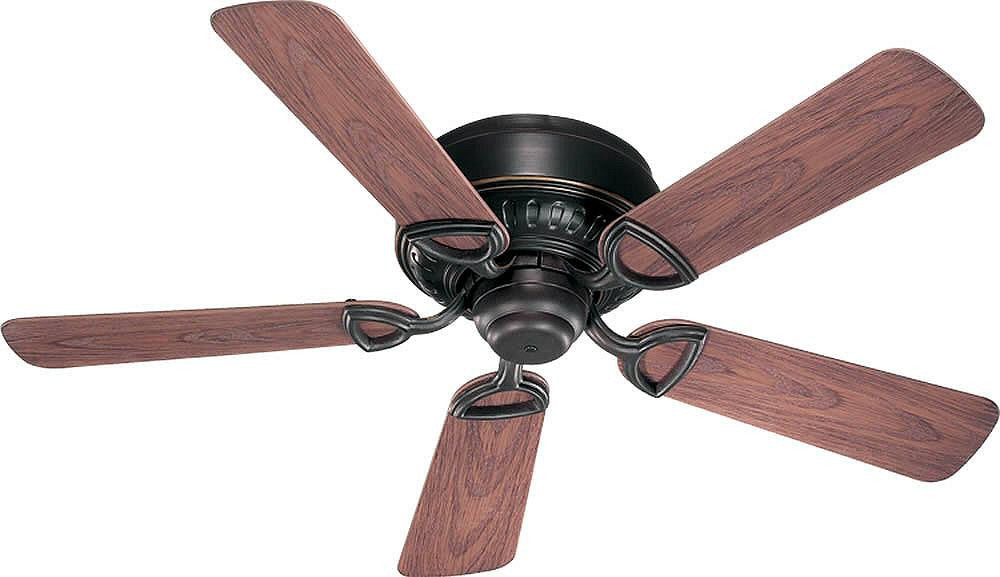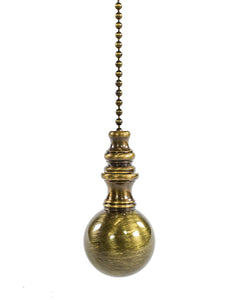Quorum 42"W Medallion Patio Hugger Indoor/Outdoor 5-Blade Patio Ceiling Fan Old World

42"W Medallion Patio Hugger Indoor/Outdoor 5-Blade Patio Ceiling Fan Old World
This Medallion Patio Ceiling Fan by Quorum, with an Old World finish, is perfect your patio or sun room. With a UL listing for both dry and wet locations, this fan is versatile and can be installed inside or outside. This 5-blade ceiling fan will create a breeze capable of keeping you cool on those hot summer days.- Old World Finish
- Traditional style
- 5 x Walnut Blades
- 5 blades with a 42" total blade-span and 14-degree blade pitch
- Overall fan height: 8"
- Height from ceiling to bottom of blades: 7.25"
- Housing Width: 10.71"
- Motor Size: 153mm x 13mm
- Features a 14-Pole Motor
- Detachable Switch Cup for optional light kit installation (light kit not included)
- Skirted Blade Arms
- Sealed Vent Holes
- Suitable for patio/covered outdoor use (not wet)
- Three unique speed settings
- Amps: 0.42 on High, 0.31 on Medium, 0.19 on Low
- Watts: 50 on High, 25 on Medium, 9 on Low
- Revolutions per Minute: 240 RPM on High, 179 RPM on Medium, 102 RPM on Low
- Includes a pull-chain switch with High/Medium/Low/Off settings
- Fan may be run in reverse using a switch on the fan motor
- Includes 8" of Lead Wire
- Limited Lifetime motor warranty
- Does NOT include a remote control
- Compatible with the 7-3000 Remote Control from Quorum (not included)
- Part of the Medallion Patio Collection by Quorum International
- UL Listed for Damp locations (not wet - e.g. a covered patio)
- Weight: 15.75 lbs
|
|
|||||
| Revolution Speed (RPM - Revolutions per Minute) | Air Flow (CFM - Cubic Feet of Air Flow per Minute) | Electricity (Watts - Electricity used not including any Lights) | Efficiency (CFM/Watt - Cubic Feet of Air Flow per Minute per Watt used - higher is better) | AMPs (Amperage of Electrical Current used) | |
| HIGH Speed | 240 | 3860 | 54 | 71 | 0.42 |
| MEDIUM Speed | 179 | 25 | 0.31 | ||
| LOW Speed | 102 | 9 | 0.19 | ||
| Efficiency is the cubic feet of air that can be moved in one minute if the fan were to use 1 watt of electricity, and can be used to compare energy-efficiency among different ceiling fans. The higher this number the more energy-efficient the fan is. This ceiling fan's airflow efficiency is about average, compared to fans with less than a 52" blade span. By comparison, other small-sized ceiling fans with less than a 52" blade span typically provide an airflow efficiency ranging from 38 to 82 cubic feet per minute per watt. | |||||
Elegant Design and Timeless Style
The 42" Medallion Patio Hugger Indoor/Outdoor 5-Blade Patio Ceiling Fan by Quorum is a perfect blend of elegance and functionality. Featuring an Old World finish, this ceiling fan adds a touch of classic charm to any space. The five walnut blades are beautifully crafted, each with a 14-degree blade pitch, ensuring optimal air circulation. The traditional style of this fan makes it a versatile addition to various room themes, from rustic to vintage-inspired interiors.
Versatile Indoor and Outdoor Use
This ceiling fan is designed for both indoor and outdoor use, making it an excellent choice for patios, sunrooms, or covered outdoor areas. With a UL listing for damp locations, it can withstand the elements when installed in a covered outdoor space. Its compact design, with an overall height of just 8 inches, ensures it fits seamlessly into rooms with low ceilings, providing efficient cooling without taking up too much space.
Powerful Performance
Equipped with a robust 14-pole motor, the Medallion Patio Ceiling Fan delivers powerful performance across three unique speed settings. On high speed, it achieves 240 RPM, generating an impressive airflow of 3860 CFM. This ensures you stay cool and comfortable even on the hottest days. The fan also features a pull-chain switch with High/Medium/Low/Off settings, allowing you to easily adjust the speed to your preference. Additionally, the fan can be run in reverse using a switch on the motor, making it useful for circulating warm air during colder months.
Energy Efficiency
This ceiling fan is designed with energy efficiency in mind. It consumes only 54 watts on high speed, 25 watts on medium, and a mere 9 watts on low speed. Its airflow efficiency is about average compared to other small-sized ceiling fans, providing a balance between performance and energy consumption. This makes it an eco-friendly choice that helps reduce your energy bills while keeping your space cool.
Easy Installation and Customization
The Medallion Patio Ceiling Fan comes with a detachable switch cup, allowing for optional light kit installation (light kit not included). This feature provides flexibility to customize the fan according to your lighting needs. The fan includes 8 inches of lead wire, making installation straightforward and hassle-free. Although it does not come with a remote control, it is compatible with the 7-3000 Remote Control from Quorum (not included), offering additional convenience if desired.
Durability and Warranty
Constructed with high-quality materials, this ceiling fan is built to last. The sealed vent holes and skirted blade arms add to its durability, ensuring it remains in excellent condition even with regular use. Quorum stands behind the quality of their products, offering a limited lifetime motor warranty for added peace of mind.
Ideal Placement and Usage
The Medallion Patio Ceiling Fan is ideal for various spaces such as living rooms, bedrooms, dining areas, and covered patios. Its traditional design complements a wide range of interior styles, including rustic, vintage, and classic themes. Place it in the center of the room for balanced air distribution, or install it over seating areas to create a comfortable environment for relaxation and socializing. This fan is perfect for enhancing the ambiance of your home while providing practical cooling solutions.
Order Now
Enhance your living space with the timeless elegance and reliable performance of the 42" Medallion Patio Hugger Indoor/Outdoor 5-Blade Patio Ceiling Fan by Quorum. Whether you're looking to cool down your patio or add a stylish touch to your indoor space, this fan is the perfect choice. Don't miss out on this versatile and energy-efficient solution. Order now and experience the comfort and style it brings to your home.

What is an Ceiling Fan?
 A ceiling fan is a fairly large ceiling-mounted fan which can rotate clockwise or anticlockwise. In one direction the fan blows air downward, while in the other it draws air upwards. Some fans come equipped with a light fixture to double as a central light. The fan is a hardwired fixtures so has to be installed electrically. Typically it is used with a wall switch or remote control. Ceiling fans can help keep you cool in summer and also warmer in winter by circulating the air.
A ceiling fan is a fairly large ceiling-mounted fan which can rotate clockwise or anticlockwise. In one direction the fan blows air downward, while in the other it draws air upwards. Some fans come equipped with a light fixture to double as a central light. The fan is a hardwired fixtures so has to be installed electrically. Typically it is used with a wall switch or remote control. Ceiling fans can help keep you cool in summer and also warmer in winter by circulating the air.
Ceiling Fan Benefits
- Circulates air for healthier breathing.
- Reversible direction for summer/winter.
- Blows air onto bodies for direct cooling.
- Draws hot air upwards for ambient cooling.
- Optional speeds for varying effect.
- May add to lighting (if light is included or addedd).
- Saves on electrical heating bills.
- Keeps rooms fresher and helps remove odors.
- Provides a gentle breeze over a bed or chair.
- Usually can be manually (pull chain) or wall (switch) operated.
- Helps to remove or distribute hot rising air.
Traditional Style
Classic in nature, yet elegant by design best describes the timeless appeal of predictable yet dignified lines and curves. Traditional Style Lighting prides itself on stately structure, beautiful ornate details, and reliable designs that tell a story of enduring appeal and craftsmanship. It’s a tried-and-true style that is reliable, and speaks of discriminating and taste of a steadfast lifestyle.
For which rooms?
A ceiling fan needs enough headroom, so is ideal over some furniture such as a couch, seating area or bed. See hugger fans for maximizing headroom. Fans are most often used in living rooms, family rooms and bedrooms, where people might be dwelling for a longer period of time.
Placement/Layering
A fan is best positioned either centrally in the room or above a main seating or sleeping area. If the fan has a light it can help to light the room. We recommend adding either wall lights or some lamps to fill out the space.
Mounts to the Ceiling
Attaches to a ceiling. The ceiling should be flat, unless the fan supports sloped/vaulted ceilings. A small canopy will conceal the electrical installation.
Installed by an Electrician
An electrician or person with electrical installation knowledge will need to permanently wire the ceiling fan into the building's electrical supply.
Resources
Learn how to choose ceiling fans with our Energy Star lighting
We've shopped for you!
You're getting the the lowest prices, guaranteed!
Thousands of items are on sale every day. Plus you're tax-free unless you live in Wisconsin.
Want a different price? Contact us for a personalized quote.
Safely checkout with our world-class encryption.
Trusted by over 100,000 customers, your private and payment data is secure and will not be shared.
We accept Visa, Mastercard, Discover and Paypal. Credit cards can also be processed through Paypal.
Spend $49.00 to get Free Shipping (contiguous USA).
Most other items ship for $9 in 1-3 business days (contiguous USA). QuickShip items ship out the next business day.
Depending on your location, shipments take on average 3-5 business days or up to 7-10 from coast to coast. We ship from multiple locations.
You will receive tracking numbers by email when your items ship out, via Fedex, UPS or USPS.
You'll be able to track the packages online or on our site.
You can also talk to our team of experts at any time, or Live Chat.
Enjoy 30 days for easy returns. See our return policy for details.
We replace breakages/damages/missing parts etc for free.
Every item is covered under our extended 1-year warranty.





